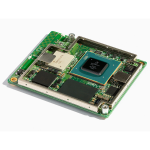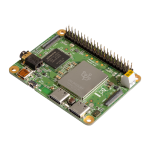PRODUCT DETAILS
Attention
This product has shipping restriction to certain countries. It can only be sent to countries and regions listed as below: United States, Japan, Korea, Hong Kong, Taiwan, Australia, New Zealand, India, Ghana, Singapore , Oman, Philippines, Thailand, Austria, Belgium, Bulgaria, Croatia, Cyprus, Denmark, Estonia, Fiji, Germany, Greece, Hungary, Ireland, Italy, Latvia, Lithuania, Luxembourg, Malta, Netherlands, Poland, Portugal, Romania, Slovakia, Slovenia, Spain, Sweden, United Kingdom, Switzerland, Iceland, Liechtenstein, Norway, Turkey
Features
- Provides a complete system: The Coral SoM is a fully-integrated Linux system that includes NXP’s iMX8M system-on-chip (SoC), eMMC memory, LPDDR4 RAM, Wi-Fi, and Bluetooth, and the Edge TPU coprocessor for ML acceleration. It runs a derivative of Debian Linux we call Mendel.
- Performs high-speed ML inferencing: The onboard Edge TPU coprocessor is capable of performing 4 trillion operations (tera-operations) per second (TOPS), using 0.5 watts for each TOPS (2 TOPS per watt). For example, it can execute state-of-the-art mobile vision models such as MobileNet v2 at 400 FPS, in a power-efficient manner.
- Integrates with your custom hardware: The SoM connects to your own baseboard hardware with three 100-pin connectors.
- Supports TensorFlow Lite: No need to build models from the ground up. TensorFlow Lite models can be compiled to run on the Edge TPU.
- Supports AutoML Vision Edge: Easily build and deploy fast, high-accuracy custom image classification models to your device with AutoML Vision Edge.
Description
The Coral System-on-Module (SoM) is a fully-integrated system that helps you build embedded devices that demand fast machine learning (ML) inferencing. It contains NXP’s iMX 8M system-on-chip (SoC), eMMC memory, LPDDR4 RAM, Wi-Fi, and Bluetooth, but its unique power comes from Google’s Edge TPU coprocessor for high-speed machine learning inferencing.
The Edge TPU is a small ASIC designed by Google that provides high-performance ML inferencing with a low power cost. For example, it can execute state-of-the-art mobile vision models such as MobileNet v2 at almost 400 FPS, in a power-efficient manner. This on-device processing reduces latency, increases data privacy, and removes the need for a high-bandwidth connection used to perform ML inferencing in the cloud.
Key benefits of the SoM:
- High-speed and low-power ML inferencing (4 TOPS @2 W)
- A complete Linux system (running Mendel, a Debian derivative)
- Small footprint (40 x 48 mm)
The SoM is also included in the Coral Dev Board, which is a single-board computer that enables fast prototyping and evaluation of the standalone SoM.
Specifications
- NXP i.MX 8M SoC
- Quad-core ARM Cortex-A53, plus Cortex-M4F
- 2D/3D Vivante GC7000 Lite GPU and VPU
- Google Edge TPU ML accelerator
- Cryptographic coprocessor
- Wi-Fi 2×2 MIMO (802.11b/g/n/ac 2.4/5 GHz)
- Bluetooth 4.2
- 8GB eMMC
- 2GB LPDDR4
- USB 3.0
- Gigabit Ethernet
- HDMI and MIPI-DSI
- MIPI-CSI-2
- Up to 95x GPIO (including SPI, I2C, PWM, UART, SAI, and SDIO)
| Feature | Details |
|---|---|
| Main system-on-chip (i.MX8M) | |
| Arm Cortex-A53 MPCore platform | Quad symmetric Cortex-A53 processors:
Support of 64-bit Armv8-A architecture:
|
| Arm Cortex-M4 core platform |
|
| Graphic Processing Unit (GPU) |
|
| Video Processing Unit (VPU) |
|
| I/O connectivity |
Note: The list above is the number of signals available to the baseboard (after considering SoC signals used by the SoM). |
| On-chip memory |
|
| External memory |
|
| Display | HDMI Display Interface:
MIPI-DSI Display Interface:
|
| Audio |
|
| Camera |
|
| Security |
|
| ML accelerator | |
| Edge TPU coprocessor |
|
| Memory and storage | |
| Random-access memory (SDRAM) |
|
| Flash memory (eMMC) |
|
| Expandable flash (MicroSD) |
|
| Network & wireless | |
| Ethernet |
|
| Wi-Fi | Murata LBEE5U91CQ module:
|
| Bluetooth | Murata LBEE5U91CQ module:
|
| Security | |
| Cryptographic coprocessor | Microchip ATECC608A cryptographic coprocessor:
|
| Hardware interface | |
| Baseboard connectors | 3x 100-pin connectors (Hirose DF40C-100DP-0.4V) |
| Antenna connectors | 2x coaxial cable connectors (Murata MM8930-2600) |
Block Diagrams
Block diagram of the SoM components
Block diagram of the i.MX8M SoC components, provided by NXP
Dimensions
Part List
1 x Coral System-on-Module (SoM) – 2GB RAM Version
ECCN/HTS
| HSCODE | 8543709990 |
| USHSCODE | 8473301140 |
| UPC |
Coral System-on-Module (SoM) – 2GB RAM Version
$160.00
The Coral System-on-Module (SoM) is a fully-integrated system that helps you build embedded devices that demand fast machine learning (ML) inferencing. It contains NXP’s iMX 8M system-on-chip (SoC), eMMC memory, LPDDR4 RAM, Wi-Fi, and Bluetooth, but its unique power comes from Google’s Edge TPU coprocessor for high-speed machine learning inferencing.
Coral System-on-Module (SoM) – 2GB RAM Version
$160.00
The Coral System-on-Module (SoM) is a fully-integrated system that helps you build embedded devices that demand fast machine learning (ML) inferencing. It contains NXP’s iMX 8M system-on-chip (SoC), eMMC memory, LPDDR4 RAM, Wi-Fi, and Bluetooth, but its unique power comes from Google’s Edge TPU coprocessor for high-speed machine learning inferencing.
PRODUCT DETAILS
Attention
This product has shipping restriction to certain countries. It can only be sent to countries and regions listed as below: United States, Japan, Korea, Hong Kong, Taiwan, Australia, New Zealand, India, Ghana, Singapore , Oman, Philippines, Thailand, Austria, Belgium, Bulgaria, Croatia, Cyprus, Denmark, Estonia, Fiji, Germany, Greece, Hungary, Ireland, Italy, Latvia, Lithuania, Luxembourg, Malta, Netherlands, Poland, Portugal, Romania, Slovakia, Slovenia, Spain, Sweden, United Kingdom, Switzerland, Iceland, Liechtenstein, Norway, Turkey
Features
- Provides a complete system: The Coral SoM is a fully-integrated Linux system that includes NXP’s iMX8M system-on-chip (SoC), eMMC memory, LPDDR4 RAM, Wi-Fi, and Bluetooth, and the Edge TPU coprocessor for ML acceleration. It runs a derivative of Debian Linux we call Mendel.
- Performs high-speed ML inferencing: The onboard Edge TPU coprocessor is capable of performing 4 trillion operations (tera-operations) per second (TOPS), using 0.5 watts for each TOPS (2 TOPS per watt). For example, it can execute state-of-the-art mobile vision models such as MobileNet v2 at 400 FPS, in a power-efficient manner.
- Integrates with your custom hardware: The SoM connects to your own baseboard hardware with three 100-pin connectors.
- Supports TensorFlow Lite: No need to build models from the ground up. TensorFlow Lite models can be compiled to run on the Edge TPU.
- Supports AutoML Vision Edge: Easily build and deploy fast, high-accuracy custom image classification models to your device with AutoML Vision Edge.
Description
The Coral System-on-Module (SoM) is a fully-integrated system that helps you build embedded devices that demand fast machine learning (ML) inferencing. It contains NXP’s iMX 8M system-on-chip (SoC), eMMC memory, LPDDR4 RAM, Wi-Fi, and Bluetooth, but its unique power comes from Google’s Edge TPU coprocessor for high-speed machine learning inferencing.
The Edge TPU is a small ASIC designed by Google that provides high-performance ML inferencing with a low power cost. For example, it can execute state-of-the-art mobile vision models such as MobileNet v2 at almost 400 FPS, in a power-efficient manner. This on-device processing reduces latency, increases data privacy, and removes the need for a high-bandwidth connection used to perform ML inferencing in the cloud.
Key benefits of the SoM:
- High-speed and low-power ML inferencing (4 TOPS @2 W)
- A complete Linux system (running Mendel, a Debian derivative)
- Small footprint (40 x 48 mm)
The SoM is also included in the Coral Dev Board, which is a single-board computer that enables fast prototyping and evaluation of the standalone SoM.
Specifications
- NXP i.MX 8M SoC
- Quad-core ARM Cortex-A53, plus Cortex-M4F
- 2D/3D Vivante GC7000 Lite GPU and VPU
- Google Edge TPU ML accelerator
- Cryptographic coprocessor
- Wi-Fi 2×2 MIMO (802.11b/g/n/ac 2.4/5 GHz)
- Bluetooth 4.2
- 8GB eMMC
- 2GB LPDDR4
- USB 3.0
- Gigabit Ethernet
- HDMI and MIPI-DSI
- MIPI-CSI-2
- Up to 95x GPIO (including SPI, I2C, PWM, UART, SAI, and SDIO)
| Feature | Details |
|---|---|
| Main system-on-chip (i.MX8M) | |
| Arm Cortex-A53 MPCore platform | Quad symmetric Cortex-A53 processors:
Support of 64-bit Armv8-A architecture:
|
| Arm Cortex-M4 core platform |
|
| Graphic Processing Unit (GPU) |
|
| Video Processing Unit (VPU) |
|
| I/O connectivity |
Note: The list above is the number of signals available to the baseboard (after considering SoC signals used by the SoM). |
| On-chip memory |
|
| External memory |
|
| Display | HDMI Display Interface:
MIPI-DSI Display Interface:
|
| Audio |
|
| Camera |
|
| Security |
|
| ML accelerator | |
| Edge TPU coprocessor |
|
| Memory and storage | |
| Random-access memory (SDRAM) |
|
| Flash memory (eMMC) |
|
| Expandable flash (MicroSD) |
|
| Network & wireless | |
| Ethernet |
|
| Wi-Fi | Murata LBEE5U91CQ module:
|
| Bluetooth | Murata LBEE5U91CQ module:
|
| Security | |
| Cryptographic coprocessor | Microchip ATECC608A cryptographic coprocessor:
|
| Hardware interface | |
| Baseboard connectors | 3x 100-pin connectors (Hirose DF40C-100DP-0.4V) |
| Antenna connectors | 2x coaxial cable connectors (Murata MM8930-2600) |
Block Diagrams
Block diagram of the SoM components
Block diagram of the i.MX8M SoC components, provided by NXP
Dimensions
Part List
1 x Coral System-on-Module (SoM) – 2GB RAM Version
ECCN/HTS
| HSCODE | 8543709990 |
| USHSCODE | 8473301140 |
| UPC |






